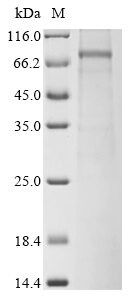The production of this recombinant Human SARM1 protein is just like all recombinant proteins. The process involved transfecting Baculovirus cells with DNA vector containing the template of recombinant DNA. The Baculovirus cells containing the template were then cultured so that they could transcribe and translate the SARM1 protein. N-terminal 10xHis tag and C-terminal Myc tag was used in the process. The purity is 0.85 determined by SDS-PAGE.
Sterile alpha and toll/interleukin receptor motif-containing protein 1, SARM1, an executor of axonal degeneration, is an autoinhibitory NAD-consuming enzyme, composed of multiple domains. NMN and its analogs, CZ-48 and VMN, are the only known activators, which can release the inhibitory ARM domain from the enzymatic TIR domain. The later discovery that SARM1 promotes Wallerian degeneration suggested the existence of a pathway that might be targeted therapeutically. More recently, SARM1 was found to execute degeneration by hydrolyzing NAD+. Notably, SARM1 knockdown or knockout prevents neuron degeneration in response to a range of insults that lead to peripheral neuropathy, traumatic brain injury, and neurodegenerative disease. To be clarified, the reduction of cellular NAD+ concentration contributes to the disassembly of SARM1's peripheral ring, which allows formation of active NADase domain dimers, thereby further depleting NAD+ to cause an energetic catastrophe and cell death.




